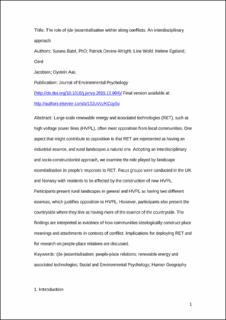| dc.contributor.author | Batel, Susana | |
| dc.contributor.author | Devine-Wright, Patrick | |
| dc.contributor.author | Wold, Line Camilla | |
| dc.contributor.author | Egeland, Helene | |
| dc.contributor.author | Jacobsen, Gerd Blindheim | |
| dc.contributor.author | Aas, Øystein | |
| dc.date.accessioned | 2020-04-23T13:39:32Z | |
| dc.date.available | 2020-04-23T13:39:32Z | |
| dc.date.created | 2015-11-11T14:01:16Z | |
| dc.date.issued | 2015 | |
| dc.identifier.citation | Journal of Environmental Psychology. 2015, 44 149-159. | en_US |
| dc.identifier.issn | 0272-4944 | |
| dc.identifier.uri | https://hdl.handle.net/11250/2652255 | |
| dc.description.abstract | Large-scale renewable energy and associated technologies (RET), such as high voltage power lines (HVPL), often meet opposition from the local communities living nearby. Research has suggested that one of the main aspects that might contribute to this is the fact that RET are represented as industrial and urban, and thus, as having a different essence from rural landscapes, where they are usually deployed and which are represented as natural and unspoilt. However, this ‘hypothesis’ of landscape essentialisation shaping people’s responses to RET has not been explicitly examined. By drawing upon research from Social Psychology and Human Geography on essentialisation, we will examine if and how landscape (de-)essentialisation plays a role in people’s responses to RET. Namely, by examining it as a rhetorical construction that can be strategically used to negotiate and legitimize given relations with place and associated responses to RET. Focus groups were conducted in the UK and Norway with members of local communities to be affected by the construction of HVPLs that will connect to new low carbon energy technologies. Analyses show that participants present British and Norwegian rural landscapes in general and HVPL as having two different essences, which justifies opposition to those infrastructures. However, analyses also show that essentialisation of the countryside is strategically used. Namely, participants also present the countryside in the place where they live as having more of the essence of the British or Norwegian countryside than other areas of the UK and Norway. In turn, this allows them to legitimize claims that whereas HVPL are ‘out of place’ in the countryside in general, they are more so in the place where they live. The implications of these results for the definition of acceptable locations for RET and for research on people-place relations and responses to place change, are discussed. | en_US |
| dc.language.iso | eng | en_US |
| dc.rights | Attribution-NonCommercial-NoDerivatives 4.0 Internasjonal | * |
| dc.rights.uri | http://creativecommons.org/licenses/by-nc-nd/4.0/deed.no | * |
| dc.subject | (de-)essentialisation | en_US |
| dc.subject | People–place relations | en_US |
| dc.subject | Renewable energy and associated technologies | en_US |
| dc.subject | Social psychology | en_US |
| dc.subject | Human geography | en_US |
| dc.title | The role of (de-)essentialisation within siting conflicts: An interdisciplinary approach | en_US |
| dc.type | Peer reviewed | en_US |
| dc.type | Journal article | en_US |
| dc.description.version | acceptedVersion | en_US |
| dc.subject.nsi | VDP::Samfunnsgeografi: 290 | en_US |
| dc.subject.nsi | VDP::Human geography: 290 | en_US |
| dc.source.pagenumber | 149-159 | en_US |
| dc.source.volume | 44 | en_US |
| dc.source.journal | Journal of Environmental Psychology | en_US |
| dc.identifier.doi | 10.1016/j.jenvp.2015.10.004 | |
| dc.identifier.cristin | 1288122 | |
| dc.relation.project | Norges forskningsråd: 207774 | en_US |
| cristin.unitcode | 7548,70,0,0 | |
| cristin.unitname | Termisk energi | |
| cristin.ispublished | true | |
| cristin.fulltext | postprint | |
| cristin.qualitycode | 2 | |

